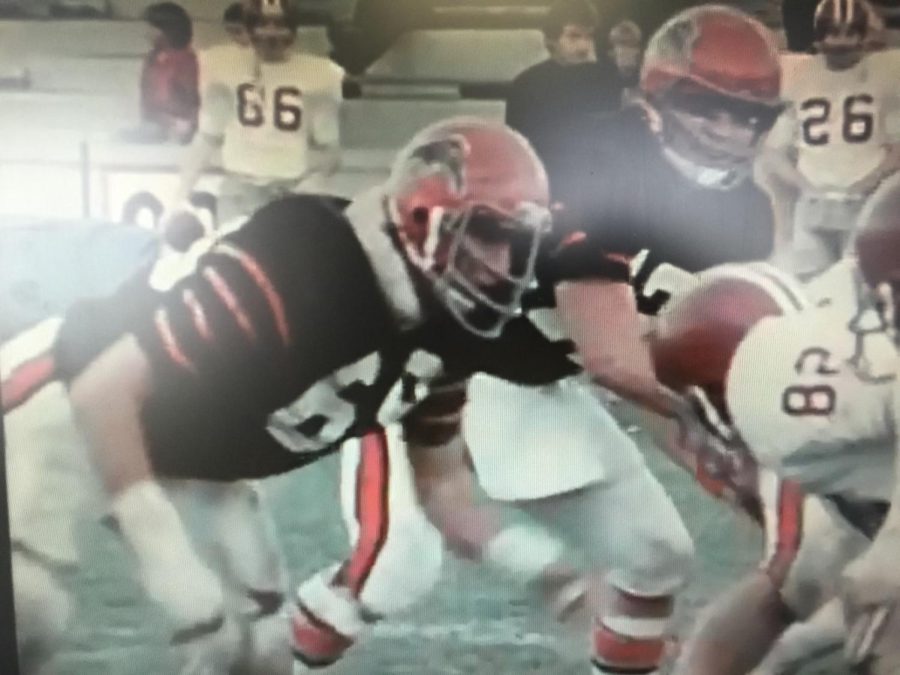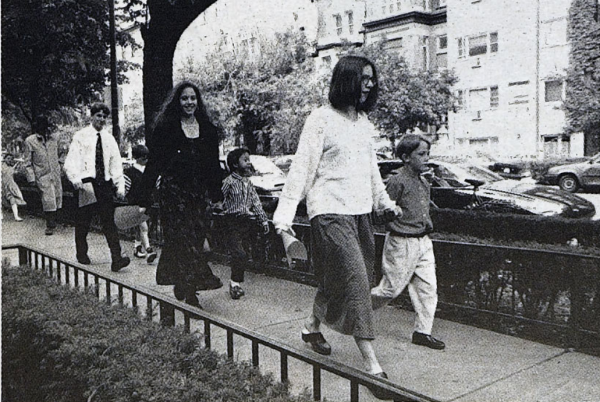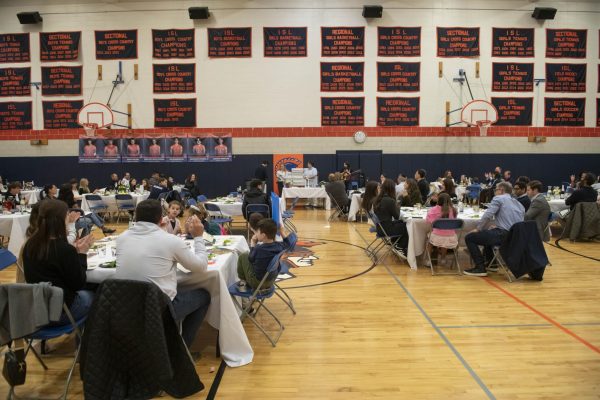Latin Football: A Story of Apathy
Peter Bastone (#69) executes a block in a game against Harvard, 1976.
Latin School boasts a number of strong athletic programs, including an Independent School League (ISL) title for boys golf and girls field hockey, a sectional championship for boys soccer, and a state championship for the girls hockey team all in the past year. Latin, however, lacks a team in America’s most popular sport: football.
The first record of Latin football was in 1901, yet Latin hasn’t fielded a team since 1974. Despite the lack of success in its later years, the program proved to be quite popular among the students. Given how successful the athletics program at Latin is today, it remains a mystery why football is no longer a part of it.
Based on viewership, football is the most popular sport in America and has been for the past several years. The most recent Super Bowl, between the Los Angeles Rams and the Cincinnati Bengals, had higher numbers than the NBA Finals, Major League Baseball World Series, and Stanley Cup Finals combined. The NFL is extremely recognizable throughout America, with an enormous amount of sponsorships, licensed video games, and a large number of celebrity appearances at games. The passion for the NFL is unmatched.
Passion for the sport doesn’t falter at the collegiate or even high school level. Certain colleges such as the University of Michigan and Penn State can hold 100,000-plus fans in their stadiums. And while the crowds are smaller at the high school level, football games do attract large crowds, as seen at schools such as St. Ignatius and Lane Tech.
Will Farrell, a senior at St. Ignatius, said he believes the football team helps improve school spirit. “The parent section is always packed, and the student section can reach north of 750 people,” he said. “It’s possible over half the student body shows up for big games.”
Will also mentioned that he has seen the team bring the school community closer together, especially after their 31-6 win against Notre Dame College Prep to put them in the 5A Final Four. No Latin team, no matter how far they’ve gone in the Illinois High School Association playoffs, has matched the same excitement that football has at various schools across Chicago.
Nevertheless, there is no denying the violent and physical nature of football. Following the spring 1973 athletics awards dinner, The Forum published a copy of former Athletic Director John Dunlop’s speech. In his speech, he stated that while successful, the team was unable to complete the season.
“The boys were fighting for [the] championship, however, due to injury to two key players we couldn’t finish the season.”
Dunlop had been the football and baseball coach for a number of years and was extremely well respected among the Latin community at the time, but that all changed after his speech.
According to Latin alum Bobby Howington ‘73, Coach Dunlop gave his speech intoxicated, and Latin officials were unimpressed. He was promptly fired, and the football program was dropped the following year.
Following Dunlop’s dismissal, football teams in the ISL began dropping like flies in the 1970s; Parker, Morgan Park Academy, and U-High all removed football from their athletic programs. Today, Lake Forest Academy is the only school in the ISL that still has a football program.
The physical nature of the sport also plays a part, and probably shrinks its chances from ever being reconsidered at Latin, especially given the emerging understanding of Chronic Traumatic Encephalopathy (CTE).
According to the Mayo Clinic, CTE is a term used to describe brain degeneration, usually caused by repeated head traumas, most commonly in football. It is a newly discovered disorder and not very well understood yet, even by scientists.
In a study at Boston University, it was found that about three in 14 high school football players would experience the effects of CTE later in life. These include but are not limited to: memory loss, substance abuse, change in personality, mood swings, and even suicide.
And it’s safe to say that the studies around CTE have placed doubts into the heads of those considering football.
Freshman Owen Woodhouse said, “I would definitely be open to [football returning]. But I definitely would not play because I’m worried about injuries.”
Owen also noted he’s not much of a “football guy” but said the fear of injury remains ever-prevalent among students and especially parents.
“Yes, I would let my sons play football if they were interested,” parent Paul Bartolai said. “But we would need to discuss it first. CTE is 100 percent a real thing, and knowing my sons most likely won’t play past high school, it’s important to make them aware of this disorder.”
Mr. Bartolai, a parent of two, acknowledges the effects of CTE and would still allow his sons to participate in football, although he does believe all tackle football before high school should cease.
Senior Braden Sedler said he’d be interested in playing despite the injury concerns but would have to get permission from his parents.
“I would play if my mom allowed me, but if I was seriously injured I would just leave,” Braden said.
If Latin football were to make a return, it is important that the possible effects and consequences of CTE be made abundantly clear to players and parents.
Another thing to be aware of is success. For the program to be successful, the team has to win, and Latin didn’t win a lot, especially in the early 1970s.
“We had one game where Morgan Park Academy beat us 84-0,” Peter Bastone ‘75, the football team’s last captain, said.
Even though the team wasn’t that strong, Bastone was a superstar, becoming captain of Princeton’s football team and enjoying a brief NFL career with the Baltimore Colts. Most importantly, he is the only person to be inducted into the Latin’s Athletics Hall of Fame for football.
Bastone was senior prefect when football was dropped, and he reminisced about how he essentially pleaded for more guys to sign up for football during an assembly. He was unable to generate interest, unfortunately a common problem that plagued Latin in the 1970s.
“At the time, the ISL, especially Latin, was very counter-cultural.” Bastone said. “There was not a lot of support for sports.”
He noted that Latin contained a lot of “apathy,” and all extracurriculars at the time were deemed frivolous by the majority of the population.
But Latin is certainly not that way now, and Bastone believes that while difficult, the return of football isn’t impossible.
“We would need close to 35 to 40 guys to make it worthwhile,” the football superstar said. “But there are many football players who are alumni that still live in Chicago. Be worthwhile to see what they could do.”
Fielding 35-40 players may be difficult to pull off, but if Latin could somehow make it work, Bastone believes it would pay great dividends.
“The school would love to see it!” Bastone said.





















































